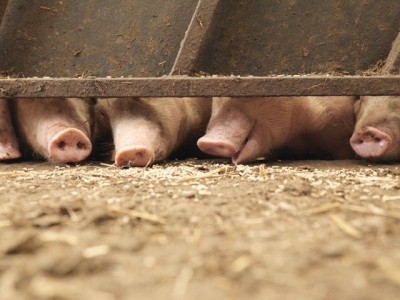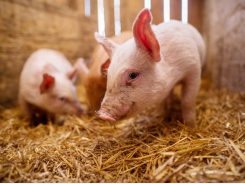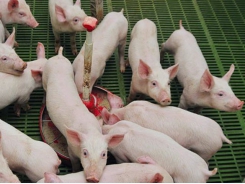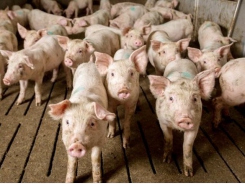Just how much do we know about taste and smell in animals?

Scientists are still learning how taste and smell systems work in farmed animals and so enormous potential remains for industry to gain and apply knowledge in the coming years, say experts
“Whether they're cows, sheep, pigs or indeed chickens, what surprises me in some ways is how little we know about the way smell works in detail in these animals,” said Dr Tristram Wyatt, senior research fellow at Oxford University's zoology department, following his presentation at Kaesler Animal Nutrition's 2019 forum 'The Power of Flavors' in Cuxhaven last week.
This was despite olfaction studies showing “time and time again” how important this sense was for animals, particularly for feeding, Wyatt told FeedNavigator.
Because focus had been for a long time “so much more about the immediate effect on yields”, rather than the sensory physiology of animals, he said there remained “enormous potential” for better understanding sense of smell in animals.
“I think we ought to be studying the sense of smell in domesticated animals in far more detail. There are so many things we do not know, even about the most familiar animal – the domesticated dog. And if you think about cattle, sheep and pigs, there is so much more we could understand to our benefit.”
So, what do we know?
'For many, many species olfaction is vital for survival'
Olfaction, or sense of smell, is the most widespread and likely oldest sense present in unicellular organisms through to humans, said Professor Ivan Manzini from the Institute of Animal Physiology at Germany's Giessen University.
“And the organization and anatomy is very similar if you compare the olfactory system of a bee, and other insects, to ours. It is built almost in the same way. That's very, very interesting,” Manzini told attendees at the forum.
“For many, many species, [olfaction] is vital for survival (…) It alerts to danger – for many animals it's important to smell a predator so they can escape – and it's important for foraging, to find food. Then many, many species use the sense of olfaction, smell, for orientation and navigation. The sense of smell is also important for intra-specific communication – pheromones.”
Olfactory receptors in mammals, he said, represented about 3% of the entire genome – the largest family of g-protein coupled receptors in the genome – showing just how important olfaction was.
Mice had more than double the receptors found in humans (1,000) showing how important the system remained for this animal, he said, but chickens, by comparison, had a very poor sense of smell with just 80 olfactory receptors and fish around 100.
Despite its importance, Manzini said olfaction remained “the least understood sense”, particularly in animals. “...It's known what receptors they have, of course, but it's not known how [the system] really works”. For example, how g-protein couple receptors reversibly bound an odorant – detaching it at some point.
Most knowledge, Manzini said, had only really been established in the last 20 years.
An important few decades...
Dr Peihua Jiang, associate member of Philadelphia-based, Monell Chemical Senses Center, said the same was true for taste research.
“Over the past 20 years, our field has made tremendous advances in understanding taste receptors for detecting sugar, bitter compounds, amino acids, etc.,” Jiang told attendees.
It was now understood, for example, that sense of taste was an “innate behavior” decoded by different taste receptors and perception differed from species to species, he said.
Some animals even lacked certain receptors associated with specific tastes, like cats that had no functional T1R2 receptor and therefore could not taste sweet compounds, he said. A loss of functional T1R2 receptors in meat-eating species, Jiang said, was likely due to the “relaxation of selective pressures” which maintained receptor integrity.
Jiang said what was clear for all species, however, was the inter-connection between taste and smell. He said there is lots of research actively ongoing in relation to this.
"So we'll have a much better understanding over the next few years."
Wyatt said another ongoing research topic was an animal's ability to detect pheromones – first chemically identified 60 years ago by German Nobel Prize laureate, Adolf Butenandt.
Almost all pheromones, he said, were identified through smell – many through the vomeronasal organ which was separate but inter-connected to the main olfactory system – and sheep had become “one of the model systems” for investigating how animals remember each other through smell, with mother ewes learning the smell of a newborn within an hour.
Knowledge on the role of pheromones in animal relationships and mating systems, he said, enabled improved farming practices but also a better understanding on animal welfare, which ultimately had implications for animal nutrition.
Professor Dr Kai-Markus Müller, founder and CEO of The Neuromarketing Labs and professor of consumer behavior at Germany's HFU Business School, talked about interesting human behavioral experiments that looked at parameters like food intake and hormone levels that could prove relevant for industry.
“All of the five senses are there for animals as well, so we should be paying attention.”
However, Müller said it would be best for industry to first focus on identifying the “basic perceptual mechanisms” in the animal mind. “Using that then in designing animal foods, well it might be interesting,” he said, providing the effort and challenges weren't too significant.
Related news
Tools

Phối trộn thức ăn chăn nuôi

Pha dung dịch thủy canh

Định mức cho tôm ăn

Phối trộn phân bón NPK

Xác định tỷ lệ tôm sống

Chuyển đổi đơn vị phân bón

Xác định công suất sục khí

Chuyển đổi đơn vị tôm

Tính diện tích nhà kính

Tính thể tích ao




 High-protein canola meal appropriate for gestating, lactating sows
High-protein canola meal appropriate for gestating, lactating sows  Bacteria implicated in gastric ulcer development in pigs
Bacteria implicated in gastric ulcer development in pigs